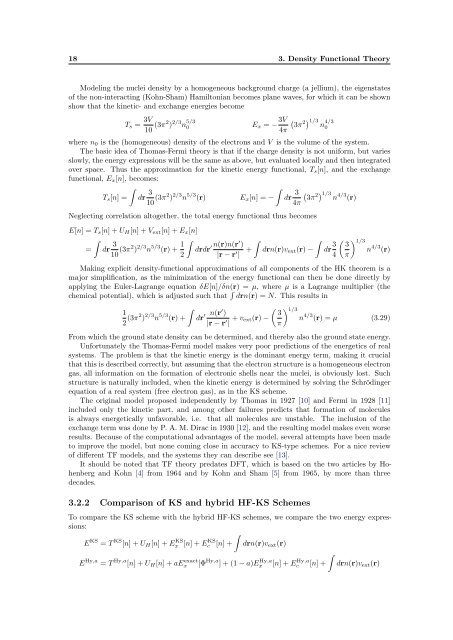Exact Exchange in Density Functional Calculations
Exact Exchange in Density Functional Calculations
Exact Exchange in Density Functional Calculations
You also want an ePaper? Increase the reach of your titles
YUMPU automatically turns print PDFs into web optimized ePapers that Google loves.
18 3. <strong>Density</strong> <strong>Functional</strong> TheoryModel<strong>in</strong>g the nuclei density by a homogeneous background charge (a jellium), the eigenstatesof the non-<strong>in</strong>teract<strong>in</strong>g (Kohn-Sham) Hamiltonian becomes plane waves, for which it can be shownshow that the k<strong>in</strong>etic- and exchange energies becomeT s = 3V10 (3π2 ) 2/3 n 5/30 E x = − 3V (3π2 ) 1/3 4/3 n 04πwhere n 0 is the (homogeneous) density of the electrons and V is the volume of the system.The basic idea of Thomas-Fermi theory is that if the charge density is not uniform, but variesslowly, the energy expressions will be the same as above, but evaluated locally and then <strong>in</strong>tegratedover space. Thus the approximation for the k<strong>in</strong>etic energy functional, T s [n], and the exchangefunctional, E x [n], becomes:∫T s [n] = dr 3 10 (3π2 ) 2/3 n 5/3 (r)∫E x [n] = −Neglect<strong>in</strong>g correlation altogether, the total energy functional thus becomesE[n] = T s [n] + U H [n] + V ext [n] + E x [n]∫= dr 3 10 (3π2 ) 2/3 n 5/3 (r) + 1 ∫drdr ′ n(r)n(r′ )2 |r − r ′ |∫+dr 3 (3π2 ) 1/3n 4/3 (r)4π∫drn(r)v ext (r) −dr 3 4( 3π) 1/3n 4/3 (r)Mak<strong>in</strong>g explicit density-functional approximations of all components of the HK theorem is amajor simplification, as the m<strong>in</strong>imization of the energy functional can then be done directly byapply<strong>in</strong>g the Euler-Lagrange equation δE[n]/δn(r) = µ, where µ is a Lagrange multiplier (thechemical potential), which is adjusted such that ∫ drn(r) = N. This results <strong>in</strong>∫12 (3π2 ) 2/3 n 5/3 (r) +dr ′ n(r ′ ( ) 1/3)3|r − r ′ | + v ext(r) − n 4/3 (r) = µ (3.29)πFrom which the ground state density can be determ<strong>in</strong>ed, and thereby also the ground state energy.Unfortunately the Thomas-Fermi model makes very poor predictions of the energetics of realsystems. The problem is that the k<strong>in</strong>etic energy is the dom<strong>in</strong>ant energy term, mak<strong>in</strong>g it crucialthat this is described correctly, but assum<strong>in</strong>g that the electron structure is a homogeneous electrongas, all <strong>in</strong>formation on the formation of electronic shells near the nuclei, is obviously lost. Suchstructure is naturally <strong>in</strong>cluded, when the k<strong>in</strong>etic energy is determ<strong>in</strong>ed by solv<strong>in</strong>g the Schröd<strong>in</strong>gerequation of a real system (free electron gas), as <strong>in</strong> the KS scheme.The orig<strong>in</strong>al model proposed <strong>in</strong>dependently by Thomas <strong>in</strong> 1927 [10] and Fermi <strong>in</strong> 1928 [11]<strong>in</strong>cluded only the k<strong>in</strong>etic part, and among other failures predicts that formation of moleculesis always energetically unfavorable, i.e. that all molecules are unstable. The <strong>in</strong>clusion of theexchange term was done by P. A. M. Dirac <strong>in</strong> 1930 [12], and the result<strong>in</strong>g model makes even worseresults. Because of the computational advantages of the model, several attempts have been madeto improve the model, but none com<strong>in</strong>g close <strong>in</strong> accuracy to KS-type schemes. For a nice reviewof different TF models, and the systems they can describe see [13].It should be noted that TF theory predates DFT, which is based on the two articles by Hohenbergand Kohn [4] from 1964 and by Kohn and Sham [5] from 1965, by more than threedecades.3.2.2 Comparison of KS and hybrid HF-KS SchemesTo compare the KS scheme with the hybrid HF-KS schemes, we compare the two energy expressions:∫E KS = T KS [n] + U H [n] + ExKS [n] + Ec KS [n] + drn(r)v ext (r)∫E Hy,a = T Hy,a [n] + U H [n] + aExexact [Φ Hy,a ] + (1 − a)ExHy,a [n] + Ec Hy,a [n] + drn(r)v ext (r)












